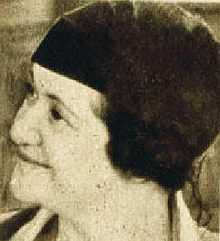Emma Dunn
| Emma Dunn | |
|---|---|
 Emma Dunn | |
| Born |
26 February 1875 Cheshire, England, UK |
| Died |
14 December 1966 (aged 91) Los Angeles, California, U.S. |
| Occupation | Actress |
| Years active | 1914–1948 |
| Spouse(s) | John Stokes (marriage dissolved)[1] |
| Children | 2 |
Emma Dunn (26 February 1875 – 14 December 1966) was an English-born actress and writer. She appeared in 108 films between 1914 and 1948.
Stage career
Emma Dunn appeared onstage in her early teens, graduating to the London stage for several years and later became a noted Broadway actress. She appeared in the first American production of Ibsen's Peer Gynt (1906) with Richard Mansfield as Peer. She played Peer's mother, Ase, even though she was, in real life, 20 years younger than Mansfield. She appeared in three productions for theatre impresario David Belasco: The Warrens of Virginia (1907), The Easiest Way (1909) and The Governor's Lady (1912). In The Easiest Way, Dunn portrayed Annie, who was black, in blackface. In 1913 Dunn appeared in Vaudeville.[2] Dunn wrote two books regarding voice quality and speech: Thought Quality in the Voice (published in 1933) and You Can Do It (published in 1947).
Film career
Dunn made her first film in 1914, a silent film of her 1910 stage success, Mother, directed by Maurice Tourneur. This was Tourneur's first American film. Dunn's second film was 1920's Old Lady 31, reprising the role she played in the 1916 Broadway play of the same name. One more silent film followed in 1924, Pied Piper Malone, before she made her talkie debut in Side Street co-starring the Moore brothers, Matt, Owen and Tom as her sons.
Personal life
Dunn was born in Cheshire, England, and died in Los Angeles, California. She was married to an actor named John Stokes,[3] but the union was dissolved. The couple had two daughters, according to a 1915 magazine article on Dunn.[4] Daughter Dorothy (standing in photo) was their biological child, while Helen was their adopted daughter.[5]
Partial filmography
- Mother (1914)
- Old Lady 31 (1920)
- Pied Piper Malone (1924; re-discovered in Russia)
- Manslaughter (1930)
- The Bad Sister (1931)
- Too Young to Marry (1931)
- Morals for Women (1931)
- The Guilty Generation (1931)
- Hell's House (1932)
- Elmer, the Great (1933)
- Dark Hazard (1934)
- Dr. Monica (1934)
- George White's 1935 Scandals (1935)
- The Glass Key (1935)
- Ladies Crave Excitement (1935)
- Little Big Shot (1935)
- The Emperor's Candlesticks (1937)
- Madame X (1937)
- Lord Jeff (1938)
- Three Loves Has Nancy (1938)
- Young Dr. Kildare (1938)
- Thanks for the Memory (1938)
- Son of Frankenstein (1939)
- Scattergood Baines (1941)
- Minesweeper (1943)
- The Bridge of San Luis Rey (1944)
- Life with Father (1947)
- The Woman in White (1948)
References
- ↑ Who Was Who in the Theatre: 1912-1976, Vol. 2, D-H, p. 720; originally published annually by John Parker; this 1976 edition published by Gale Research Company
- ↑ EMMA DUNN IN VAUDEVILLE; Appears at the 5th Avenue in New Sketch - New York Times June 10, 1913
- ↑ John Stokes;IBDb.com Retrieved April 12, 2015
- ↑ Emma Dunn and her two daughters, ca. 1915 by the Byron Company, magnoliabox.com; accessed 22 October 2014.
- ↑ The Green Book Magazine, Volume 15, p. 103 c. 1916; "Emma Dunn As A Real Mother", books.google.com; accessed 22 October 2014.
External links
| Wikimedia Commons has media related to Emma Dunn. |
- Emma Dunn at the Internet Movie Database
- Emma Dunn at the Internet Broadway Database
|